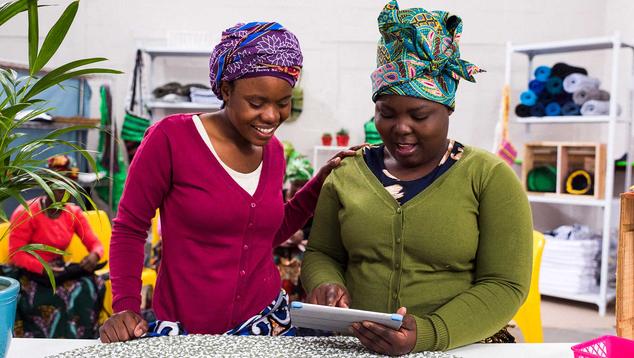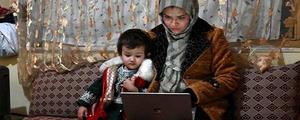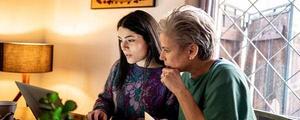A Conversation With Magali Rheault
Gallup's Regional Director for the World Poll in Sub-Saharan Africa
So, the U.N. Women’s theme for International Women’s Day this year focuses on the digital gender divide and how it feeds into widening economic and social inequalities around the world. Access to technology, of course, is a basic element of this.
You’ve been asking women (and men) in your region for years whether they have access to the internet through their phone, computer or some other device.
A lot of the countries in sub-Saharan Africa have big gender gaps in internet access. Women lag behind men by at least 10 percentage points in 22 countries. While access is getting higher in most countries, the gaps between men and women are just as big.
Can you talk about this a little bit? What are some of the changes you’ve noticed over the years as women and men have become more connected -- or not? What have you seen happening?
Rheault: Before we delve into gender differences, I’d like to provide the 30,000-foot view. Digital infrastructure in sub-Saharan Africa is still relatively limited compared with other regions. Mobile broadband -- the main means of internet access for Africans -- has a penetration rate of about 25%, the lowest of all regions in the world. Not only that, but poor and unreliable electricity combined with high costs of data plans make it difficult for many to access the internet. The United Nations Broadband Commission estimated it will cost over $100 billion to bring about the digital transformation in the region to achieve nearly universal, reliable and affordable access for more than 1 billion Africans by 2030. It’s an ambitious undertaking that will require deep collaboration between governments, regulatory entities, investors, the private sector and users.
Against this backdrop, relatively few Africans (be they women or men) currently benefit from the tremendous opportunities the internet offers. Internet penetration varies greatly across countries. According to our World Poll results, the leading country in the region is Mauritius, where more than eight in 10 adults have access to the internet, with no statistically significant gender differences (81% among women vs. 83% among men).
Similarly in Zimbabwe, our results show virtually no gender differences, although overall access is much lower at 46%. At the lower end of the spectrum, just 23% of adults in Madagascar are connected (21% among women and 25% among men), and access is confined to cities. These results underscore the big differences between connected urban and under-connected rural residents where cellular mobile network coverage is limited.
Having said that, our results also reveal persistent gender differences, and they certainly merit deeper analysis. The gap tops 20 points in the Republic of the Congo, where 25% of women vs. 47% of men have access. In neighboring Democratic Republic of the Congo, this difference is also staggering, as 14% of women vs. 35% of men report having access. In several other countries, including Ghana, Nigeria and Senegal, the gender gap is at least 15 percentage points. So, we most certainly have a great deal of gender inequality on internet access.
What are the barriers to internet access for women in your region?
Rheault: Female literacy and education explain such differences to some extent. Many countries have made great strides on the education front for young girls and women. But the gender gap in internet access provides a novel lens through which we can measure progress. Women who have completed primary education or less are far more likely to be without internet access compared with those who have completed at least secondary schooling or higher. Also, when looking at Africans with a university-level education, there is no gender difference on access.
Financial dependence or lack of income represents another significant barrier. Many women depend on someone else to provide for them. This is changing, of course, as more women started to work during the pandemic to make up for a loss of income from other family members. Still, if a woman has to choose between buying food or purchasing her own data plan, her priority will likely go to feeding her family.
Related to financial dependence is culture, which we discussed in previous editions of our International Women’s Day coverage. But it’s worth repeating that many Africans still hold traditional views of gender roles, where women are confined to house chores and taking care of children. Attitudes toward gender roles and values do change -- they just take time. Ironically, it’s the internet and social media that put the pedal to the metal and are helping change attitudes across the region.
Obviously, there are economic implications, but what are other costs of digital exclusion for women and girls in sub-Saharan Africa?
Rheault: It’s more powerful to think in terms of digital inclusion. What I mean is let’s instead take a look at what women have already achieved. There’s a track record, and we can measure its economic impact. In virtually every country on the continent, thousands of women have harnessed the power of the internet and used digital tools to invent new products, build businesses, share knowledge, be mentors and contribute to making their communities better places.
On the entrepreneurship front alone, African women have quickly learned how to tap the internet successfully to sell products, set up payment platforms and connect with and retain customers. From the neighborhood hairdresser who trained herself to do more sophisticated styles of braids by watching YouTube videos to the university graduate who built a mobile-money platform for employees without a bank account, these tech-savvy entrepreneurs reach far and wide; they created personal and professional change for themselves and more prosperity for their families and communities. And by the way, these women are just getting started.
Digitalization is rapidly transforming society, but digital exclusion is far from the only challenge facing women and girls in sub-Saharan Africa.
Many of the problems they faced before the pandemic -- such as gender-based violence and lack of access to education -- only became worse during the pandemic. And then, in parts of Africa, famine, drought and rising food costs made these situations worse.
How have things changed since the pandemic? For better or worse?
Rheault: That’s true and I certainly don’t want to minimize the challenges. In particular, the loss of income during the pandemic and the higher cost of living -- as many countries need to import food staples and gasoline -- have exacted a severe toll on African women. At the same time, these challenges have forced them to take up an economic activity. Not only did it provide an additional source of income for the family, even if modest, but having an economic activity also gave women more self-assurance, independence and self-awareness. Extreme hardship led women to innovation and eventually to a path on the journey of self-empowerment.
Younger Africans have more exposure to social media and the internet than their elders do. They have been exposed to other ways of thinking about gender roles. And they look at gender relations through a different lens, especially if they’ve achieved a certain level of education.
When they become parents, they want to teach their children about gender equality and mutual respect and break the harmful stereotypes still surrounding the expected role of women. Just like previous generations, this tech-savvy generation of parents wants a better world for their children, but they also are more aware of the need to give girls the runway they need to grow and prosper on an equal footing with boys.
Tell me about some of the positive changes you are seeing for women -- if you are seeing any. What gives you hope?
Rheault: The power of education cannot be underestimated. There has been good progress on girls’ school enrollment and completion, even though there is still a long way to go. A handful of countries include STEM education in their curriculum, and this assumes solid numeracy skills, but here again, it is a step in the right direction.
Funding from private companies has made possible powerful training programs. For example, Siemens, in partnership with U.N. Germany, has launched the “African Girls Can Code Initiative” to train more than 600 young women in five countries on ICT, coding and leadership skills. Beyond these important initiatives, it’s African women’s resilience and can-do attitude, no matter what the barrier, that is such a source of inspiration and hope for even better days ahead.
Read more stories about women around the world on our International Women's Day page.




